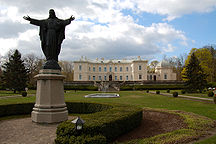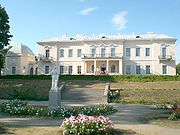
Tiškeviciai Palace, Palanga
Encyclopedia


The Tiškevičiai Palace, Tiskevičius Palace, or Tyszkiewicz Palace is a Neo-Renaissance
Neo-Renaissance
Renaissance Revival is an all-encompassing designation that covers many 19th century architectural revival styles which were neither Grecian nor Gothic but which instead drew inspiration from a wide range of classicizing Italian modes...
style building in Palanga
Palanga
Palanga and beautiful sand dunes. Officially Palanga has the status of a city municipality and includes Šventoji, Nemirseta, Būtingė and other settlements, which are considered as part of the city of Palanga.-Legend:...
, Lithuania
Lithuania
Lithuania , officially the Republic of Lithuania is a country in Northern Europe, the biggest of the three Baltic states. It is situated along the southeastern shore of the Baltic Sea, whereby to the west lie Sweden and Denmark...
, built for the Tyszkiewicz (Tiškevičiai) family. The construction was started in 1893 and finished in 1897. The palace is surrounded by a park with ponds, fountains, and collections of rare plants. Since 1963 the palace has housed the Palanga Amber Museum
Palanga Amber Museum
The Palanga Amber Museum , near the Baltic Sea in Palanga, Lithuania, is a branch of the Lithuanian Art Museum. It is housed in the restored 19th-century Tiškevičiai Palace and is surrounded by the Palanga Botanical Garden. The museum's collection of amber comprises about 28,000 pieces, of which...
and is surrounded by the Palanga Botanical Garden.
History
Tyszkiewicz family member, Feliks Tyszkiewicz, contacted famous GermanGermany
Germany , officially the Federal Republic of Germany , is a federal parliamentary republic in Europe. The country consists of 16 states while the capital and largest city is Berlin. Germany covers an area of 357,021 km2 and has a largely temperate seasonal climate...
architect Franz Heinrich Schwechten
Franz Heinrich Schwechten
Franz Heinrich Schwechten was one of the most famous German architects of his time, and has contributed to the development of the historicist architecture....
to construct a new palace; their old estate was a wooden manor on the banks of Rąžė River. The first stage of construction lasted until 1897, consisting of the terrace and main residence building. The two story building had regular form with an arched terrace, decorated with sculptures from France
France
The French Republic , The French Republic , The French Republic , (commonly known as France , is a unitary semi-presidential republic in Western Europe with several overseas territories and islands located on other continents and in the Indian, Pacific, and Atlantic oceans. Metropolitan France...
. Although mainly neo-Renaissance
Neo-Renaissance
Renaissance Revival is an all-encompassing designation that covers many 19th century architectural revival styles which were neither Grecian nor Gothic but which instead drew inspiration from a wide range of classicizing Italian modes...
in style, it also has neoclassical
Neoclassical architecture
Neoclassical architecture was an architectural style produced by the neoclassical movement that began in the mid-18th century, manifested both in its details as a reaction against the Rococo style of naturalistic ornament, and in its architectural formulas as an outgrowth of some classicizing...
and baroque
Baroque architecture
Baroque architecture is a term used to describe the building style of the Baroque era, begun in late sixteenth century Italy, that took the Roman vocabulary of Renaissance architecture and used it in a new rhetorical and theatrical fashion, often to express the triumph of the Catholic Church and...
elements. Because in 1907 his wife, Antonina, delivered a healthy baby boy (Stanislaw) after a worrisome pregnancy, Feliks commissioned a sculpture of the blessing Jesus
Jesus
Jesus of Nazareth , commonly referred to as Jesus Christ or simply as Jesus or Christ, is the central figure of Christianity...
for the front of the palace. While the creator of this sculpture is unclear, there is evidence it was made by Danish
Denmark
Denmark is a Scandinavian country in Northern Europe. The countries of Denmark and Greenland, as well as the Faroe Islands, constitute the Kingdom of Denmark . It is the southernmost of the Nordic countries, southwest of Sweden and south of Norway, and bordered to the south by Germany. Denmark...
artist Bertel Thorvaldsen
Bertel Thorvaldsen
Bertel Thorvaldsen was a Danish-Icelandic sculptor of international fame, who spent most of his life in Italy . Thorvaldsen was born in Copenhagen into a Danish/Icelandic family of humble means, and was accepted to the Royal Academy of Arts when he was eleven years old...
or his apprentice. In 1948 the religious sculpture was torn down under the instructions by the Soviet authorities
Lithuanian SSR
The Lithuanian Soviet Socialist Republic , also known as the Lithuanian SSR, was one of the republics that made up the former Soviet Union...
. It was reconstructed based on surviving photographs in 1993. Almost a decade after the construction of the palace, the owners started to construct a chapel near by, also designed by Schwechten.
The palace gardens were designed by Édouard François André, French horticulturalist and landscape architect
Landscape architect
A landscape architect is a person involved in the planning, design and sometimes direction of a landscape, garden, or distinct space. The professional practice is known as landscape architecture....
, and his son. André started work on gardens in 1895, taking three years to complete the work. In preparing the land for the gardens, old trees were cut down and new species were brought in. Some locals refused to cut down trees, as they thought they were sacred.
In 1916, an attempt at palace expansion was started, with Heinrich Schwechten being requested to prepare designs for expanding the upper floors and veranda, but these projects were never completed. During World War I
World War I
World War I , which was predominantly called the World War or the Great War from its occurrence until 1939, and the First World War or World War I thereafter, was a major war centred in Europe that began on 28 July 1914 and lasted until 11 November 1918...
, the palace was damaged in German bombardment. After World War II
World War II
World War II, or the Second World War , was a global conflict lasting from 1939 to 1945, involving most of the world's nations—including all of the great powers—eventually forming two opposing military alliances: the Allies and the Axis...
, the palace was nationalized and suffered from neglect. In 1957, palace renovations were conducted by Alfredas Brusokas, with the building serving for the Lithuanian Art Union. In the 1960s, the palace and surrounding gardens received attention form architect Kazys Šešelgis, who with associates started preparing plans to renovate the palace and surrounding gardens. In 1963, it officially became the Amber Museum.
Countess Antonina, her son, Stanislaw, his wife Wanda, and their daughter, Renia were forced to flee from their Palanga home during WWII. When it became clear that they could never safely return, they accepted resettlement in Canada. Count Stanislaw bequeathed his share of the family estate to his wife Wanda Tyszkiewicz. The other heir of the Tiškevičiai (Tyszkiewicz
Tyszkiewicz
The Tyszkiewicz family was a wealthy and influential magnate family of Ruthenian/Lithuanian nobility with roots traced into the times of the Grand Duchy of Lithuania...
) family, count Alfred Tyszkiewicz (1913–2008), Stanislaw's younger brother, was also forced to leave Lithuania during the Second World War, he donated his share of the palace to the city of Palanga. On May 22, 1997 he was honored with the title of Honorary Citizen of Palanga.
Amber Museum
The museum's collection of amberAmber
Amber is fossilized tree resin , which has been appreciated for its color and natural beauty since Neolithic times. Amber is used as an ingredient in perfumes, as a healing agent in folk medicine, and as jewelry. There are five classes of amber, defined on the basis of their chemical constituents...
comprises about 28,000 pieces, of which about 15,000 contain inclusions of insects, spiders, or plants. About 4,500 pieces of amber are exhibited; many of these are items of artwork and jewelry. The museum holds the third largest amber specimen in Europe
Europe
Europe is, by convention, one of the world's seven continents. Comprising the westernmost peninsula of Eurasia, Europe is generally 'divided' from Asia to its east by the watershed divides of the Ural and Caucasus Mountains, the Ural River, the Caspian and Black Seas, and the waterways connecting...
, the "Sun Stone", weighing over 3.5 kilograms, which has been stolen twice. The cultural and artistic exhibits of museum currently include a 15th century ring, a 16th century cross, and amber jewelry from the past four centuries, as well as a number of modern decorations.

